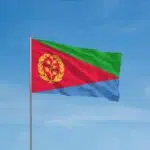Martyrs’ Day in Eritrea — known as ‘Maelti Siwuat’ in the Tigrinya language — is celebrated on June 20 every year. It is a day of remembrance for those who perished in the war while fighting for freedom between 1961 and 1991. Eritrea had been a colony of Italy since 1890 but during the Second World War, Britain annexed the land from Italy. Then in 1949, Britain administered Eritrea as a United Nations trust territory. An uprising by Eritreans, who were fed up with the current system, began in 1961, signaling the start of the war. Independence was finally achieved in 1991.
History of Martyrs' Day in Eritrea
The Italian colonial push into Africa was interrupted by the loss at the battle of Adua in 1869, which resulted in the formation of the region that is now known as Eritrea. In 1936, Italy launched an invasion of Ethiopia and promptly included the country as a colony in their empire.
After the allies won the Second World War and drove the Italians back into their country, the international community was split on the best course of action regarding Eritrea. Resolution 390 of the United Nations General Assembly brought about the federation of Ethiopia and Eritrea in 1952. Eritrea was meant to have some level of autonomy within the federation, but in 1962, Ethiopian Emperor Haile Selassie acted unilaterally to dissolve the Eritrean parliament and unlawfully invade the country.
This resulted in the Eritrean War of Independence, which lasted until May 1991, when the Eritreans successfully ousted the People’s Democratic Republic of Ethiopia in Eritrea.
It is estimated that approximately 10% of Eritrea’s total population perished as a direct result of the conflict. This national holiday was created by Eritrea as a way to honor the people who lost their lives fighting for the nation’s independence.
In 1997, the National Martyrs’ Park was opened, which is located just outside the city of Asmara (the country’s capital). The park has a National Martyrs’ Monument with the names of the martyrs engraved on it and museums that detail the 30-year fight for independence. Eritreans can visit the park to pay their respects to these fallen heroes.
Martyrs' Day in Eritrea timeline
Italy colonizes Eritrea and establishes a colonial administration there.
An uprising starts in Eritrea because people are fed up with the system.
In May, the Eritrean War of Independence officially ends.
The government opens the National Martyrs' Park outside the capital.
Martyrs' Day in Eritrea FAQs
How many lives were lost?
During the Eritrean fight for independence, more than 150,000 Eritrean military and civilian lives were lost.
How long was Eritrea supposed to stay with Ethiopia?
An autonomous Eritrean state was expected to have been established by the end of the 10 years of federation, according to the Eritrean people.
What was Eritrea’s previous name?
Mdree-Bahree (Land of the Sea) was the name given to Eritrea by the locals. The term ‘Eritrea’ derives from the Greek term ‘Sinus Erythraeus,’ which can be translated in English as ‘Red Sea.’
How to Observe Martyrs' Day in Eritrea
Attend a national memorial service
Every year, Eritreans around the world hold memorial services to honor those who gave their lives in the service of the country’s noblest ideals. Thousands of Eritrean soldiers risked their lives for the sake of the country’s security, safety, and glory. It is important to pay tribute to them.
Partake in a procession
Many mourning processions and memorial services are held all around Eritrea. The National Martyr’s Park serves as the focal point of the commemorations.
Look for martyrs' names on the monument
People pay their respects to those who have passed away by looking for their names inscribed on the National Martyrs’ Monument and touring museums that detail the war for independence. This allows people to reflect on the country’s history and remember the martyrs.
5 Interesting Facts About Eritrea
The holiday is similar to Western ones
Like Memorial Day or Armistice Day, Martyr's Day in Eritrea similarly celebrates the sacrifice made by martyrs in the fight for their country’s freedom.
Home to a million-year-old skull
The Afar area in Eritrea has yielded a million-year-old skull that is associated with both Homo sapiens and Homo erectus.
A magnet for unique fish species
Eritrea’s extensive Red Sea coastline and warm waters make it a magnet for unique fish species.
Women bear arms
When the Italians and Ethiopians invaded Eritrea, women armed themselves and fought alongside their male counterparts.
Impressive architecture
It boasts one of the world’s most outstanding works of colonial architecture.
Why Martyrs' Day in Eritrea is Important
It is a day for remembrance
On this day, we both celebrate and mourn those who sacrificed their lives for their country. It is a day to remember the losses the country faced and to also recognize its triumph since then.
It inspires people
It inspires the people to serve their country wholeheartedly. Citizens should not be afraid to love their country and protect it the way those in the past did.
It is a day to honor the martyrs
Those who gave their lives for the greater good are honored today. Thousands of Eritrean soldiers risked their lives for the sake of the country’s security, well-being, and honor.
Martyrs' Day in Eritrea dates
| Year | Date | Day |
|---|---|---|
| 2026 | June 20 | Saturday |
| 2027 | June 20 | Sunday |
| 2028 | June 20 | Tuesday |
| 2029 | June 20 | Wednesday |
| 2030 | June 20 | Thursday |




















